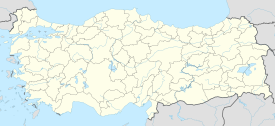Yervandashat (ancient city)
Երվանդաշատ | |
 The heights on the right bank of Aras River are the site of ancient Yervandashat | |
 Shown within Turkey | |
| Location | 1 km east of the current village of Yervandashat, Armenia, on the right bank of Aras River in modern-day Turkey |
|---|---|
| Coordinates | 40°07′N 43°39′E / 40.117°N 43.650°ECoordinates: 40°07′N 43°39′E / 40.117°N 43.650°E |
| History | |
| Builder | King Orontes IV of Armenia |
| Founded | 210 BC |
| Abandoned | 360 |
Yervandashat or Eruandashat (Armenian: Երվանդաշատ), was an Armenian city and one of the 13 historic capitals of Armenia,[1] serving as a capital city between 210 and 176 BC during the Orontid rule over Armenia and the beginning of their successors; the Artaxiad dynasty.
Etymology[]
"Eruandashat", which translates as "Joy of Ervand (i.e. Orontes)", is the Armenian form of the toponym and derives from Middle Persian *Arwandašād (compare Old Persian *Aruvanta-šiyāti-).[2][3]
History[]
Yervandashat was built around 210 BC by the last Orontid king Orontes IV of Armenia. It was at a height on the right bank of Aras River, in the Arsharunik canton of Ayrarat province of Armenia Major. Its site is 1 km east[clarification needed] of the modern Armenian village of Yervandashat, in the current Turkish Province of Iğdır.[citation needed]
According to Movses Khorenatsi, Orontes founded Yervandashat to replace Armavir as his capital after Armavir had been left dry by a shift of the Arax River.
Ancient Yervandashat was destroyed by the army of the Persian King Shapur II in the 360s AD.[4]
The archaeological site has not been the subject of major research, but preliminarily, the fortifications and some remains of palaces have been uncovered.
References[]
- ^ Cyrille Toumanoff. Studies in Christian Caucasian history. — Georgetown University Press, 1963. — С. 75.:"The capitals of Armenia were successively: Armavira or Armawir of the Orontids (Manandyan, O torgovle 37) until the transfer by Orones IV of his residence to Eruandasat (*Orontasata)"
- ^ Canepa, Matthew P. (2018). The Iranian Expanse: Transforming Royal Identity through Architecture, Landscape, and the Built Environment, 550 BCE–642 CE. University of California Press. p. 99. ISBN 978-0520964365.
- ^ Hewsen, Robert H. (1998). "ERUANDAŠAT". Encyclopaedia Iranica, Vol. VIII, Fasc. 6. p. 562.
- ^ Yervandashat
- Former capitals of Armenia
- Archaeological sites in Eastern Anatolia
- History of Iğdır Province
- Eastern Anatolia Region geography stubs
- Near East archaeology stubs
- Turkey stubs